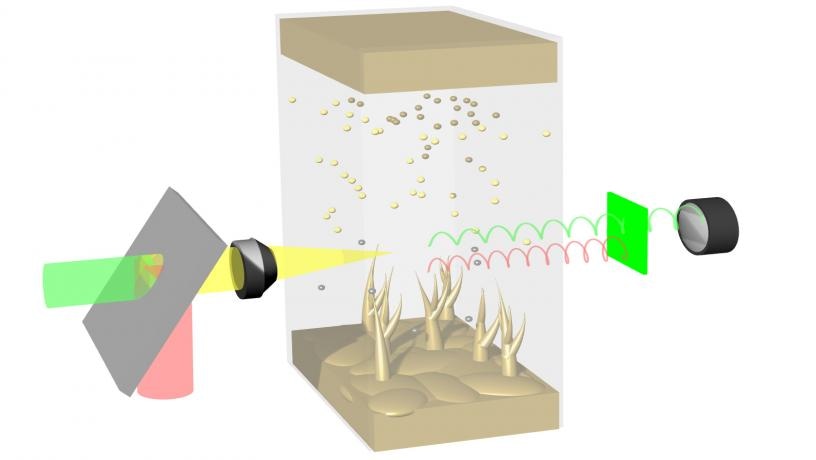Jul 31 2018
Lithium metal batteries hold remarkable promise for next-generation energy storage as the lithium metal negative electrode has ten times more theoretical specific capacity than the graphite electrode employed in commercial Li-ion batteries. It also contains the most negative electrode potential among materials for lithium batteries, making it an ideal negative electrode. However, lithium is one of the most difficult materials to work, because of its internal dendrite growth mechanism. This extremely complex process is still not completely understood and can cause Li-ion batteries to sometimes short circuit, catch fire, or even burst.
 A schematic illustration of a Li-Li symmetric cell under SRS imaging. (Image Credit: Qian Cheng/Columbia Engineering)
A schematic illustration of a Li-Li symmetric cell under SRS imaging. (Image Credit: Qian Cheng/Columbia Engineering)
While scientists are aware that the growth of dendrites, which are needle-like lithium whiskers that develop internally in battery electrodes, is influenced by how ions move in the electrolyte, they do not know how ion transport and inhomogeneous ionic concentration impact the morphology of lithium deposition. Imaging ion transport in a transparent electrolyte has been known to be very challenging, and existing methods have been unable to trap low ionic concentrations and ultrafast electrolyte dynamics.
Scientists at Columbia University recently stated that they have used Stimulated Raman Scattering (SRS) microscopy, a method extensively used in biomedical studies, to investigate the mechanism behind dendrite growth in lithium batteries and, in so doing, have become the first team of material scientists to directly witness ion transport in electrolytes. They revealed a lithium deposition process that matches to three stages: no depletion, partial depletion (a formerly unknown stage), and full depletion of lithium ions. They also discovered a feedback mechanism between lithium dendrite growth and heterogeneity of local ionic concentration that can be blocked by artificial solid electrolyte interphase in the second and third stages. The paper has been reported online in Nature Communications.
Using Stimulated Raman Scattering microscopy, which is fast enough to catch the quickly changing environment inside the electrolyte, we’ve been able to figure out not only why lithium dendrites form but also how to inhibit their growth. Our results show that ion transport and inhomogeneous ionic concentration is critical to the formation of lithium dendrites on the lithium surface. The capability to visualize ion movement will help us improve the performance of all kinds of electrochemical devices - not just batteries, but also fuel cells and sensors.
Yuan Yang, the study’s co-author and assistant professor of materials science and engineering
For this research, Yang partnered with Wei Min, professor of chemistry at Columbia University and the study’s co-author. A decade ago, Min created SRS with colleagues as a tool to map chemical bonds in biological samples. Yang learned about the method from Min’s website, and recognized that SRS might be a beneficial tool in his battery research.
SRS is three to six orders of magnitude faster than conventional spontaneous Raman microscopy. With SRS, we can acquire a 3D image of resolution of 300 nm (1/300 of the diameter of human hair) in 10 seconds with a chemical resolution of approximately 10 mM, thus making it possible to image ion transport and distribution.
Yuan Yang, the study’s co-author and assistant professor of materials science and engineering
The research exposed that there are three dynamic stages in the Li deposition process:
- A slow and relatively even deposition of moss-like Li when ionic concentration is well above 0;
- A mixed growth of mossy Li and dendrites; at this stage, Li+ depletion partly takes place near the electrode, and lithium dendrite protrusions begin to appear;
- Dendrite growth after 100% depletion. When the surface ions are completely depleted, the lithium deposition will be controlled by “dendrite growth” and one will see the rapid formation of lithium dendrites.
Stage 2 is a serious transitional point wherein the heterogeneous Li+ depletion on the Li surface prompts the lithium deposition to grow from “mossy lithium mode” to “dendrite lithium mode.” Here, two regions star to form: a dendrite region where lithium begins to deposit dendrites at a faster and faster rate, and a non-dendrite region where the lithium deposition decelerates and even stops. These results are also in keeping with predictions made from simulations performed by Pennsylvania State University collaborators, Long-Qing Chen, professor of materials science and engineering, and his PhD student Zhe Liu.
“The clever use of Stimulated Raman Scattering microscopy to visualize the electrolyte concentration within an operating electrode is a real breakthrough in the imaging of electrochemical systems,” says Martin Bazant, professor of chemical engineering and mathematics at the Massachusetts Institute of Technology. “In the case of lithium electrodeposition, the link between local salt depletion and dendritic growth was directly observed for the first time, with important implications for the design of safe, rechargeable metal batteries.”
Based on their observations, the Columbia team then formulated a technique to prevent dendrite growth by homogenizing the ionic concentration on the lithium surface at both stages 2 and 3.
“When we made the surface ion distribution uniform and mitigated the ionic heterogeneity by depositing an artificial solid electrolyte interface, we were able to suppress the dendrite formation,” says the study’s lead author Qian Cheng, a postdoctoral researcher in Yang’s lab. “This gives us a strategy to suppress dendrite growth and move on to improving the energy density of current batteries while developing next-generation energy storage.”
Min is extremely pleased that his SRS method has become such a robust tool for the materials and energy fields. “Without SRS microscopy, we would not have been able to see and validate such a clear correlation between the Li+ concentration and dendrite growth,” he says. “We are excited that more people in materials science will learn about this tool. Who knows what we will see next?”